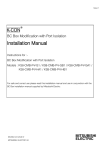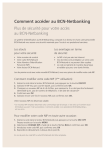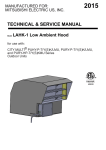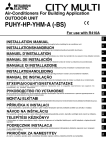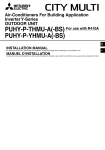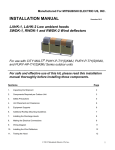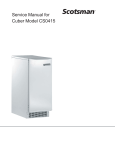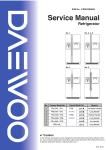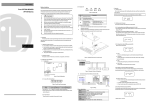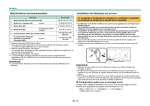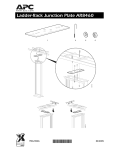Download TECHNICAL & SERVICE MANUAL
Transcript
2013 TECHNICAL & SERVICE MANUAL Model LAHK-1 Low Ambient Hood For use with CITY MULTI® PUHY-P-T/Y(S)KMU, PURY-P-T/Y(S)KMU, and PURY-HP-T/Y(S)KMU Series outdoor units 4000292 Manufactured for Mitsubishi Electric US, Inc. December 2013 © 2013 Mitsubishi Electric US, Inc. 1 LAHK-1 Control Box Component Identification Operating Sequence Outdoor Unit in Cooling Mode The LAHK-1 low ambient hood is designed to reduce the airflow through the outdoor units as the ambient temperature drops. This maintains the head pressure at a level that will allow the system to perform at 100% o capacity down to -10 F outdoor temperature. A thermistor mounted on the side of the unit senses the outdoor temperature. As the outdoor temperature drops, the resistance of the thermistor increases. The thermistor is connected to the specially designed circuit board and the resistance value from the thermistor is converted to a DC voltage output within the circuit board. This DC voltage output drives the damper actuator to a predetermined position based on the outdoor temperature. The inverter driven fan motor will adjust the discharge pressure based on system capacity demand. The motor will speed up and force more air through the damper if there is a higher system capacity demand, or slow down if system capacity demand decreases. Outdoor Unit in Heating Mode Heating mode requires the damper be in the fully open position to allow full airflow and maximum heating capacity. Heating mode automatically deactivates the kit through an interlock relay. The coil for this relay is tied into the reversing valve connection on the outdoor unit. When the unit switches to heating mode, the reversing valve is energized. This in-turn energizes the interlock relay. When the relay is energized, the normally closed contact opens. By opening this contact, the power to the transformer and control board is interrupted, this allows the damper to spring to the full open position. Outdoor Unit in Defrost Mode If the outdoor unit will be running in heating mode, a defrost period is inevitable. During defrost the low ambient controls see this as the unit operating in cooling mode. If the outdoor temperature is below 50 F, the damper will close to a position equal to that required during the cooling cycle. Once the unit comes back out of defrost and into heating mode, the damper will again spring wide open for full airflow. Operation Test Outdoor unit must be in cooling mode December 2013 © 2013 Mitsubishi Electric US, Inc. 2 All hoods and damper controls are tested at the factory before shipping. To perform an operational test once the installation has been completed, follow the steps below. Operation testing when the outdoor ambient is ABOVE 50°F 1. Turn on power to the outdoor unit. 2. Make sure the outdoor unit is in cooling mode. 3. Locate the outdoor temperature sensing thermistor at the end of the short conduit coming out the side of the control panel, it can be seen inside the plastic shield. 4. Using an aerosol dusting sprayer, invert the can and spray the thermistor with very short bursts of the cold liquid. Caution! Do Not overspray the thermistor as it could be damaged. It may take 10 – 20 seconds for the internal thermistor temperature to drop. The damper will start to move toward the closed position after the thermistor drops below 50°F 5. Once the thermistor warms above 50°F, it will move back to the full open position indicating the low ambient kit is working as designed. Operation testing when the outdoor ambient is BELOW 50°F 1. Turn on power to the outdoor unit. 2. Make sure the outdoor unit is in cooling mode. 3. The damper will move toward the closed position to a predetermined position based on the outdoor ambient temperature, indicating the low ambient kit is working as designed. If neither of these tests work. Proceed with the component troubleshooting instructions. Component Troubleshooting Thermistor The thermistor is a 10,000 Ω, NTC Type. The circuit board has a blinking indicator light built in to reference what the thermistor is sensing. The chart below shows what the blinking light sequence means. Blink(s) 1 2 3 Constant ON Thermistor Temperature Above 50F 50F to 20F Below 20F Thermistor is open or shorted If the light is on constantly, the thermistor is open or shorted and needs to be replaced. If the blinking light sequence doesn’t fall within the range given in the chart, the thermistor needs to be replaced. If it’s suspected that the thermistor is operating inaccurately, check the tolerance in the following instructions. Disconnect the thermistor from the control board. Measure the resistance across the two leads. Measure the temperature of the thermistor. (Accuracy on the temperature reading is important to prevent a good thermistor from being replaced). Compare the ohm reading with the temperature on the chart below. Based on the thermistor temperature the ohm reading should be within 1-2% of the number shown below. If not, and the thermistor connections are not corroded, the thermistor should be replaced. o F 86 84 82 81 79 77 75 73 72 70 68 66 64 63 61 Ohms 8,056 8,448 8,862 9,077 9,526 10,000 10,501 11,031 11,307 11,884 12,493 13,139 13,822 14,179 14,924 o F 59 57 55 54 52 50 48 46 45 43 41 39 37 36 34 Ohms 15,714 16,551 17,438 17,902 18,873 19,903 20,997 22,159 22,767 24,040 25,394 26,835 28,368 29,171 30,856 o Ohms 32,650 34,562 36,601 37,671 38,776 42,315 44,875 47,610 49,047 52,069 55,301 58,759 62,460 64,408 68,510 F 32 30 28 27 26 23 21 19 18 16 14 12 10 9 7 o F 5 3 1 0 -2 -4 -6 -8 -9 -11 -13 -15 -17 -18 -20 Ohms 72,906 77,620 82,676 85,340 90,962 96,999 103,486 110,460 114,141 121,921 130,295 139,313 149,030 154,169 165,048 Circuit Board Confirm the thermistor is operating properly before troubleshooting the circuit board. Make sure the control board has 24 Volts AC when measured at the 24 VAC and the com terminals. If not, find the cause of voltage failure. The circuit board is designed to convert the thermistor ohm input to a 2 - 9.16 VDC output to control the position of the damper actuator. Above 2 VDC output the actuator will start to move the damper toward the closed position. At 9.16 VDC, the actuator will have moved 85 degrees and the damper will be approximately 95% closed. The damper should never be 100% closed. The chart below includes the various damper angles based on the different outdoor temperatures. Measure the DC voltage output on the circuit board at com (-) and the out (+) terminals. If the output doesn’t match the thermistor input ohms as shown below, replace the circuit board. Outdoor Temperature Above 52oF 52 Thermistor Ohms N/A Control board DC volts output 2.00 Damper Angle 0o full open 18,873 2.00 0o 50 45 40 35 30 25 20 19,903 22,767 26,104 30,000 34,562 39,917 46,220 3.25 4.50 5.80 7.04 7.90 8.75 9.16 15 30o 45o 60o 70o 80o 85o Below 20oF N/A 9.16 85o o Transformer December 2013 © 2013 Mitsubishi Electric US, Inc. 3 The transformer is 208/230 – 24volt AC. For proper connections to the outdoor unit, the following diagram and instructions should be referred to. Damper Actuator Before trouble shooting the damper motor, verify the two factory switches are in the position shown below. Damper Actuator red black red white blue Black (1) Common Red (2) + Hot White (3) 2-10VDC Orange (5) Y=0 Y=0 Factory switch positions The low ambient kit is designed to function with both 208/230 volt and also 460 volt outdoor units. On 208 volt units the CNAC2 connector will provide 208 volts to the control transformer. On 230 volt units the CNAC2 connector will provide 230 volts to the control transformer. The 460 volt units include a transformer that reduces the outdoor unit internal voltage to 230 volts. Because of this, on the 460 volt units the CNAC2 connector will also provide 230 volts to the control transformer. Once the proper connection is confirmed, measure voltage on the primary side of the transformer. It should be 208 or 230 +- 10% depending on the supply voltage at the outdoor unit. If there is no voltage on the primary side of the transformer check the fuse that is located in the fuse holder inside the outdoor unit. See wiring diagram for fuse location. Once power has been confirmed at the primary side of the transformer, check the secondary/low voltage side of the transformer it should be approximately 27 volts. If no voltage is present, replace transformer. Interlock Relay The interlock relay uses a normally closed contact to allow power to flow to the transformer energizing the low ambient kit control circuitry. Any time the outdoor unit is in cooling mode, this contact will be in closed. When the outdoor unit reversing valves energizes (switches to heating mode) the coil of the relay is energized, opening this contact. This in-turn deenergizes the transformer, disconnecting power to the low ambient kit control circuitry. This allows the damper to spring return to the full open position during heating mode. To check, make sure the contact is closed when the outdoor unit is in cooling mode (coil de-energized) and the contact is open when the outdoor unit is in the heating mode (coil energized). Make sure the motor has 24 volts on the (1) Common and (2) +Hot connections. If not, find the cause of the voltage failure and correct. The damper actuator receives a DC voltage signal from the circuit board. This voltage can be measured between (1) Common and (3) 2-10VDC connections. The damper actuator has an angle indicator where it clamps onto the damper shaft linkage. Compare the DC voltage supply to the damper angle indicator position in the chart below. The angle should be within 2% of the chart shown below. If not, check to make sure the damper started off in the correct position. 0 Degrees IMPORTANT! It’s possible that during shipping, the damper shaft may have moved in the actuator shaft clamp assembly. With power off, make sure the damper is in the full open position. 0 degrees If necessary, loosen the shaft clamp on the actuator, move the damper to the 100% open position, and re-clamp tightly. If the damper actuator angle doesn’t match within 2%, with the corresponding control board voltage supplied as shown below, the damper actuator should be replaced. Outdoor Temperature Thermistor Ohms N/A Control board DC volts output 2.00 0o full open 18,873 2.00 0o 50 45 40 35 30 25 20 19,903 22,767 26,104 30,000 34,562 39,917 46,220 3.25 4.50 5.80 7.04 7.90 8.75 9.16 15 30o 45o 60o 70o 80o 85o Below 20oF N/A 9.16 85o Above 52oF 52 December 2013 © 2013 Mitsubishi Electric US, Inc. Damper Angle o 4 Use the following diagrams and instructions for this procedure. Damper Actuator Manual Override IMPORTANT! Never manually override the damper position if the outdoor unit could switch to heating mode during the override period. Heating mode requires the damper to be fully open for full capacity. It may be desirable to manually override the damper position and lock it into position until repairs can be completed. If so, select an average temperature typical for the outside environment during the override period, and then use that average temperature to find the desired damper angle in the chart below. Outdoor Temperature Above 52oF 52 Thermistor Ohms N/A Control board DC volts output 2.00 Damper Angle 0o full open 18,873 2.00 0o 50 45 40 35 30 25 20 19,903 22,767 26,104 30,000 34,562 39,917 46,220 3.25 4.50 5.80 7.04 7.90 8.75 9.16 15 30o 45o 60o o 70 80o o 85 Below 20oF N/A 9.16 85o o Follow the instructions below for manually positioning and locking the damper in place. IMPORTANT! Disconnect power to the damper motor before locking in place. The damper actuator comes with a crank handle attached, to manually move the damper position. The crank handle is removable and if it’s missing, a 3/16” allen wrench will work just as well. Angle Indicator December 2013 © 2013 Mitsubishi Electric US, Inc. 5 LAHK-1 Parts List July 2012 Damper Control Box Part Description Damper Actuator Transformer 208/230 - 24vac, 40VA Interlock Relay 240 volt coil Circuit Board Thermistor harness assy CN505 Connector CNAC2 Connector Part Number NFB24-SR R68AA0005 R68AB0006 CB-LAHK-1-A TH-LAHK-1-A HC-LAHK-1-1A HC-LAHK-1-2A Wire Harness Components CN505 Connector Part Number: HC-LAHK-1-1A Includes everything shown White Red White Red CNAC2 Connector Part Number: HC-LAHK-1-2A Includes everything shown Black 1 amp fuse Black Black Orange White White Note: Damper linkage parts can be purchased locally. If damper blades or complete assembly needs replacing, order new LAHK-2 hood and damper assembly Manufactured for Mitsubishi Electric and Electronics USA December 2013 © 2013 Mitsubishi Electric US, Inc. 6 Wiring Diagram LAHK-1 Wiring Diagram Control Box Mounted on Hood green 40 VA Transformer Ground orange orange white white black black red red Damper Actuator 208v R 24 V 230V 4 red Com red black red C 5 white 240 volt ac Black (1) Common Red (2) + Hot White (3) 2-10VDC Orange (5) Y=0 Y=0 NC Relay red blue 1 3 Terminal strip Circuit Board + Sensor Factory switch positions 2-10VDC - C24v+ Outdoor Unit Control Board 10K ohm thermistor CNAC2 Connection common (blk) 1 amp fuse 230/460v (wh) 208v (or) white CNAC2 F Insert the black plug into the CNAC2 connection on the board. Connect the white wire (male connector) to the wire that corresponds to the outdoor unit supply voltage as shown below move and secure cap to unused wire 208 volt = orange wire (female connector) 230/460 volt = white wire (female connector) CN505 Connection To reversing valve 21S4a yellow red Part Number LAHK-1 Supply Voltage 208/230V, 1-phase, 60Hz M F red Low Ambient Hood black F M M F 6 5 4 3 2 1 Amps 0.20 Fuse Size 1 amp For use with Modular PURY and PUHY outdoor units T/Y(S)KMU Series Only Serial Number Date of Manufacture CN505 Initials green Disconnect white plug with four wires from the CN505 connection. Plug the white male connector from the low ambient kit onto the CN505 connection. Connect the white plug with four wires onto the spare connection. Manufactured for Mitsubishi Electric and Electronics USA, Inc Manufactured for Mitsubishi Electric US, Inc. December 2013 © 2013 Mitsubishi Electric US, Inc. 7







